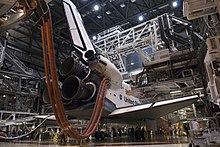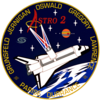From Wikipedia, the free encyclopedia
Endeavour
OV-105 |
|---|

Space Shuttle Endeavour on launch pad 39A prior to mission STS-127, July 15, 2009. |
| OV designation | OV-105 |
|---|
| Country | United States |
|---|
| Contract award | July 31, 1987 |
|---|
| Named after | HMS Endeavour |
|---|
| Status | Active |
|---|
| First flight | STS-49
May 7, 1992 - May 16, 1992 |
|---|
| Last flight | STS-134
April 29, 2011-May 13, 2011 |
|---|
| Number of missions | 25 |
|---|
| Crews | 148 |
|---|
| Time spent in space | 280 days, 9 hours, 39 minutes, 44 seconds |
|---|
| Number of orbits | 4,429 |
|---|
| Distance travelled | 166,003,247 km (103,149,636 mi) |
|---|
| Satellites deployed | 3 |
|---|
| Mir dockings | 1 |
|---|
| ISS dockings | 10 |
|---|
(The other is
Atlantis.)
Endeavour is the fifth and final spaceworthy NASA space shuttle to be built, constructed as a replacement for
Challenger.
Endeavour first flew in May 1992 on mission
STS-49 and was scheduled for decommissioning in 2010.
Before its decommissioning, NASA expects to use
Endeavour for the
STS-134 mission. Its STS-134 mission was originally thought as the final mission of the Space Shuttle program, however, the proposed
STS-135 mission was approved, and now
Atlantis will be the final Space Shuttle to fly.
The orbiter is named after the British
HMS Endeavour, the ship which took Captain
James Cook on his
first voyage of discovery (1768–1771).
This is why the name is spelled in the
British English manner, rather than the
American English ("Endeavor"). This has caused confusion, most notably when NASA themselves misspelled a sign on the launch pad in 2007.
Endeavour was named through a national competition involving students in elementary and secondary schools. Entries included an essay about the name, the story behind it and why it was appropriate for a NASA shuttle, and the project that supported the name.
Endeavour was the most popular entry, accounting for almost one-third of the state-level winners. The national winners were Senatobia Middle School in
Senatobia, Mississippi, in the elementary division and
Tallulah Falls School in
Tallulah Falls, Georgia, in the upper school division. They were honored at several ceremonies in Washington, D.C., including a White House ceremony where then-President
George H.W. Bush presented awards to each school.
Endeavour was delivered by
Rockwell International Space Transportation Systems Division in May 1991 and first launched a year later, in May 1992, on
STS-49. Rockwell International claimed that it had made no profit on Space Shuttle
Endeavour, despite construction costing US$2.2 billion. On its first mission, it captured and redeployed the stranded
INTELSAT VI communications satellite. The first African-American woman astronaut,
Mae Jemison, was brought into space on the mission
STS-47 on September 12, 1992.
Endeavour completed its latest Orbiter Major Modification period, which began in December 2003, and ended on October 6, 2005. During this time, the Orbiter Vehicle-105 received major hardware upgrades, including a new, multi-functional, electronic display system, often referred to as
glass cockpit, and an advanced
GPS receiver, along with safety upgrades
recommended by the
Columbia Accident Investigation Board (CAIB) for shuttle return to flight after the
disintegration of sister-ship
Columbia during re-entry on February 1, 2003.
The
STS-118 mission, the first for
Endeavour following a lengthy refit, included astronaut
Barbara Morgan, formerly assigned to the Educator Astronaut program, but now a full member of the Astronaut Corps, as part of the crew. Morgan was the backup for
Christa McAuliffe on the ill-fated
STS-51-L mission.
Upgrades and features
As it was constructed later, Endeavour was built with new hardware designed to improve and expand orbiter capabilities. Most of this equipment was later incorporated into the other three orbiters during out-of-service major inspection and modification programs. Endeavour’s upgrades include:
A 40-foot (12 m) diameter
drag chute that is expected to reduce the orbiter's rollout distance by 1,000 to 2,000 feet (300 to 610 m).
The plumbing and electrical connections needed for
Extended Duration Orbiter (EDO) modifications to allow up to 28-day missions (although a 28-day mission has never been attempted; the current record is
17 days, which was set by
Columbia).
-
An improved version of the
Auxiliary Power Units (APUs) that provide power to operate the Shuttle's hydraulic systems.
Modifications resulting from a 2005-2006 refit of Endeavour include:
The
Station-to-Shuttle Power Transfer System (SSPTS), which converts 8 kilowatts of DC power from the ISS main voltage of 120VDC to the orbiter bus voltage of 28VDC. This upgrade will allow
Endeavour to remain on-orbit while docked at ISS for an additional 3- to 4-day duration. The corresponding power equipment was added to the ISS during the
STS-116 station assembly mission, and
Endeavour flew with SSPTS capability during
STS-118.
Planned decommissioning
The successor of Challenger, Space Shuttle Endeavour is going to fly her final mission, STS-134 to the International Space Station. After the conclusion of STS-134, Endeavour will be decommissioned.
Endeavour was originally scheduled to be decommissioned in 2010 after 18 years of service, but on July 1, 2010, NASA released a statement saying the Shuttle Endeavour mission was rescheduled for February 27, 2011, instead of late November, 2010.
"The target dates were adjusted because critical payload hardware for STS-133 will not be ready in time to support the previously planned September 16 launch," NASA said in a statement. With the Discovery launch moving to November, Endeavour mission "cannot fly as planned, so the next available launch window is in February 2011," NASA said, adding that the launch dates are subject to change.
Endeavour's final flight was originally scheduled for July 29, 2010, but was postponed.
Discovery was going to be the last of the Space Shuttle program, on the
STS-133 mission to the International Space Station, which will carry the next to final components in the
ISS assembly sequence, the
EXPRESS Logistics Carrier ELC5 and ELC1, to orbit.
However, in 2008 one more mission (
STS-134) was funded, and so
Endeavour was then slated to be the final Orbiter to fly. However, one final mission,
STS-135, has also been added to the schedule and has been allocated to
Atlantis for June 2011.
NASA has offered the three remaining orbiters for museum donation once they are withdrawn from service.
Enterprise, from the Udvar-Hazy Center, will go to New York's Intrepid Sea, Air and Space Museum.
Discovery will go the
Steven F. Udvar-Hazy Center of the
National Air and Space Museum,
Atlantis will be staying in Kennedy Space Center in the Visitor Complex while the
Endeavour will go to California Science Center.
After more than twenty organizations have submitted proposals to NASA for the display of an Orbiter,
it was announced the Endeavour would be received by the
California Science Center in
Los Angeles.
However, Endeavour's Canadarm would be removed and sent to a yet-to-be-determined museum in Canada, while the other two would remain in the shuttles.
Flights
<><><><><><><>
# | <><><><><><><>
Launch date | <><><><><><><>
Designation | <><><><><><><>
Launch pad | <><><><><><><>
Landing location | <><><><><><><>
Notes | <><><><><><><>
1
|
1992-05-07
|
|
39-B
|
|
First flight of Endeavour: Capture and redeploy Intelsat VI. First three-man EVA, longest US EVA since Apollo 17. |
2
|
1992-09-12
|
|
39-B
|
|
|
3
|
1993-01-13
|
|
39-B
|
Kennedy
|
Deploy TDRS-F
|
4
|
1993-06-21
|
|
39-B
|
Kennedy
|
|
5
|
1993-12-02
|
|
39-B
|
Kennedy
|
|
6
|
1994-04-09
|
|
39-A
|
Edwards
|
|
7
|
1994-09-30
|
|
39-A
|
Edwards
|
|
8
|
1995-03-02
|
|
39-A
|
Edwards
|
|
9
|
1995-09-07
|
|
39-A
|
Kennedy
|
Wake Shield Facility and other experiments
|
10
|
1996-01-11
|
|
39-B
|
Kennedy
|
|
11
|
1996-05-19
|
|
39-B
|
Kennedy
|
|
12
|
1998-01-22
|
|
39-A
|
Kennedy
|
Rendezvous with Mir space station and astronaut exchange |
13
|
1998-12-04
|
|
39-A
|
Kennedy
|
|
14
|
2000-02-11
|
|
39-A
|
Kennedy
|
|
15
|
2000-11-30
|
|
39-B
|
Kennedy
|
|
16
|
2001-04-19
|
|
39-A
|
Edwards
|
|
17
|
2001-12-05
|
|
39-B
|
Kennedy
|
|
18
|
2002-06-05
|
|
39-A
|
Edwards
|
|
19
|
2002-11-23
|
|
39-A
|
Kennedy
|
|
20
|
2007-08-08
|
|
39-A
|
Kennedy
|
|
21
|
2008-03-11
|
|
39-A
|
Kennedy
|
|
22
|
2008-11-14
|
|
39-A
|
Edwards
|
|
23
|
|
|
39-A
|
Kennedy
|
International Space Station assembly mission which delivered the last two elements of Japan's Kibo Module along with the Spacelab Pallet-Deployable 2, and an Integrated Cargo Carrier-Vertical Light Deployable. [19]
|
24
|
2010-02-08
|
|
39-A
|
Kennedy
|
|
25
|
29 April 2011+*
|
|
39-A
|
TBD
|
International Space Station assembly mission which will deliver the Alpha Magnetic Spectrometer and the ELC-3 to the space station. This will be the final mission of Endeavour. Originally thought to be the last space shuttle program flight, one additional flight of Atlantis in June 2011 is now planned.
|
‡ Longest shuttle mission for Endeavour
+ Official launch date of this mission
* No Earlier Than (Tentative)
Tribute and mission insignias


















































